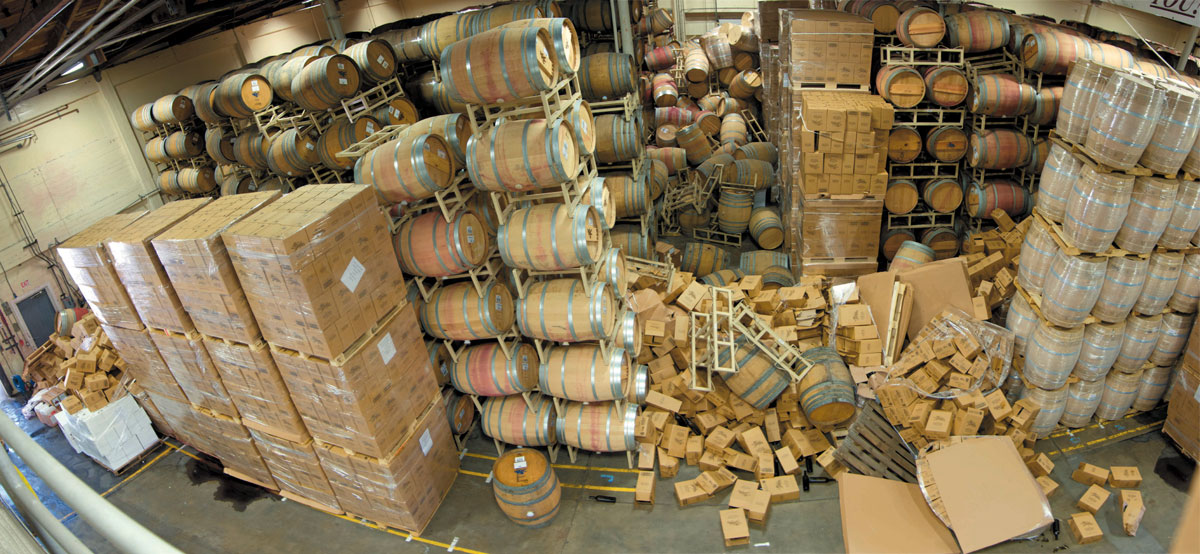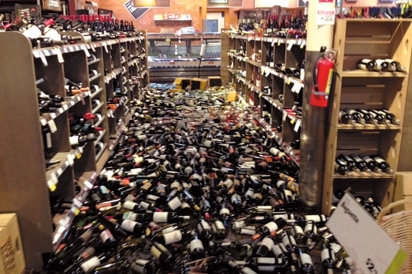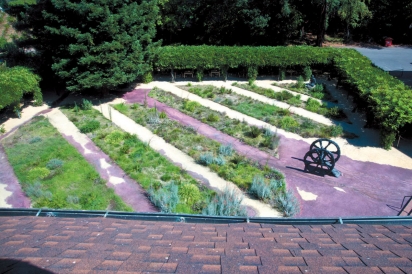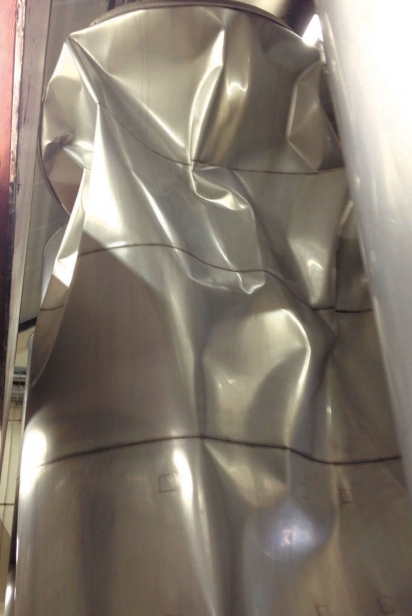15 Seconds of Hell: Rebuilding and Moving Forward After South Napa Quake
The 2014 South Napa earthquake occurred in and around the city of Napa on August 24 at 3:20am. It measured 6.0 on the moment magnitude scale (the successor to the Richter scale). The tremor’s epicenter was south of the city, at a depth of 6.7 miles (10.7 km), approximately 3.7 miles (6.0 km) northwest of American Canyon near the West Napa Fault, just west of the Napa County Airport.
This westerly location has led many locals to refer to it as the “West Napa Quake.” Most of the damage occurred on the west side of the valley and, while much of what has been publicized has been about wineries, only about a dozen were hurt in any significant way. The fact that residents and businesses downtown bore the brunt has been less publicized but is in no way less significant, and certainly not to the people involved.
“My house downtown got hammered,” says Paul Wagner of Balzac Communications & Marketing, headquartered on Jefferson Street near ground zero. “We lost the plaster on a bunch of interior walls, and everything that wasn’t on the floor before the quake was down after it—literally everything. But my worst losses were in the cellar: some very nice ports including a 1970 Warre’s and a 1977 Dow. I came upstairs with a firm conviction to stop saving wines because they just break your heart. Drink ’em now!”
The shakes lasted 10 to 20 seconds, with at least 12 aftershocks including one of magnitude 3.9. It was the largest temblor in the Bay Area since the Loma Prieta earthquake of 1989 (magnitude 6.9). It killed one person, injured about 200 and interrupted power to more than 69,000 Pacific Gas and Electric Company customers. Six major fires broke out as a result, and early figures indicate as much as a billion dollars in damage, with fewer than 5% of all of those eligible having previously purchased earthquake insurance.
One who didn’t have insurance was Jill Klein Matthiasson, who with her husband, Steve (2013 Winemaker of the Year according to the San Francisco Chronicle), and their two sons own and operate Matthiasson winery.
When we spoke this winter, Jill told me, “Our 110-year-old farmhouse slid off its foundation, and there’s damage to a barn where we keep farm equipment. We also had two barrels of our wine (about 450 cases), which were stored at a custom crush facility offsite, fall from their racks and crack open. As far as I know, no one else lost both their wine and their home! Our life is just absolutely upside down right now. We had to blow out the first story of our house, replace and reinforce it, bolt the structure back onto the foundation, and then rebuild the ground level. But we’re lucky no one was hurt. In the end, all we lost was stuff.”
NAPA GOT THE WORST
While significant destruction was reported in other parts of NorCal, including Sonoma County, where the levels of several water wells rose suddenly, in one instance by five feet; the city of Vallejo in Solano County, where hundreds of storefront windows and walls shattered and tumbled; and on Mare Island, where multiple water mains broke, by far the most extensive damage was to downtown Napa itself. Many older buildings were damaged even though several had been retrofitted, including the Goodman Library, the Sam Kee Laundry Building, the U.S. Post Office, Alexandria Hotel and Annex and the First Presbyterian Church, all of which are listed on the National Register of Historic Places.
By September 16, 156 commercial and residential structures had been “red tagged” (severely damaged to the degree that the structure was declared too dangerous to inhabit), including the Matthiassons’ home, and 1,398 had been “yellow tagged” (moderately damaged to the degree that habitability was limited, for example, only during the day). The estimate for damage to the city’s infrastructure has exceeded $57.9 million, which includes repairs to 144 water mains, repairs or replacement of a compromised water tank in Brown’s Valley and 294 separate repairs to streets and sidewalks.
“Whenever I walk to my downtown P.O. box it all comes home to me,” says Lisa Adams Walter, owner of Adams Walter Communications in Napa. “I had insisted, in fact waited on a list, to secure a box in that post office nearly eight years ago because I remember walking in with my grandmother when I was a little girl. Back then the mail service was quite important. We’d make a trip just to go to that building!”
As 2015 opened, Lisa’s postal box was still in a temporary row in an annex, the post office itself sadly shored with metal beams, the two-story glass windows still boarded up with plywood, the bricks on the corners of what always seemed to be such a solid structure and treasured landmark crumbled like stale birthday cake. On one of her sojourns past the site, Lisa noticed that a row of newspaper boxes that had long lined the nearby sidewalk, a place where people had been able to purchase local, regional and national dailies, had been closed off behind a metal fence that encircled the building. “That morning’s Napa Register was still in the box! Behind that fence, what happened that day is frozen in time.”
MORE THAN JUST PHYSICAL DAMAGE
The truly critical hours were the first few after the quake, when customers were looking for basic necessities like water and milk for children. According to Shawn Marshall, the Napa Whole Foods Market store team leader, “our biggest overall issues were loss of product, of course, but also cosmetic damage to the building and, perhaps most critically, long-lasting emotional impacts on team members and customers.”
Recovery at the store has been layered, with product being replaced within a week or so. “The building took a few months to fix and we’re still working on the sound barrier behind the store. But repairing our psyches will be an ongoing process. The emotional state of those around me was the most heartbreaking aspect of the whole experience. There was nothing I could do to go back and fix what had happened, but the continuing aftershocks and loud noises put many of those close to the epicenter right back to the moment the quake happened and this was overwhelmingly stressful.”
The most difficult physical requirement, according to Shawn, was proper disposal of hazardous waste, “due to the fact that most everything was spilled everywhere. Cleaning up that mess (as opposed to just throwing it all in the garbage) within an appropriate time frame has definitely impacted our labor expense and the overall cost of our products.”
AIR HORNS AND BULLDOZERS
Loren Trefethen’s family owns and operates a tasting room in the historic Eshcol winery that is located on their property in Napa’s Oak Knoll District. This wood building, originally built in 1886 and extensively renovated over the years, was one of the most damaged structures in the entire area.
“Our old winery handled all that Mother Nature could dish out for more than 125 years,” Loren relates, “but this was the most destructive earthquake in Napa’s recorded history. It’s a resilient building, really shook up but at least it still stands!”
The worst part of the ordeal for Loren was seeing a historical landmark tilted like a reflection in a bad funhouse mirror, but his winery’s employees have been the biggest bright spot.
“Their responses were so heartwarming. Many showed up at 4am, right after the main quake, and no matter how badly they were individually affected, just to help in any way they could. We have such a great team and now we’re even stronger and closer.”
The Trefethens set about figuring out how to rebuild their beloved winery.
“We’ve worked with all sorts of engineers and other parties, including historical architects,” says Loren, “and in January 2015 we selected the team that will help us to rebuild an even more historically accurate building.” Before the quake, much of the ground floor space was devoted to a tasting room and company offices. “Now we’re going to open up the floor plan so that we can show the historical look of the late 1800s and early 1900s.” All of this planning is, of course, subject to modern code requirements, including earthquake retrofitting to make the space more structurally sound.
Although it was business as usual on the day before the quake, priorities realigned very quickly. Loren shares that of first importance was safety, “and so we shut down the entire property for a month. Once the winery was deemed to be stable, next came harvest. We had planned to pick the week of the quake and obviously that wasn’t possible, but we managed to do it a few days later, after moving the processing line to a safe place.” Bulldozers were placed against the winery’s walls for reinforcement, and at least one employee was assigned at all times to watch the building and activate an air horn if they sighted any movement.
Tourism is also a significant part of the Trefethen experience, and Loren’s family wasn’t about to give that up, even temporarily.
“Our tasting room was in there,” explains Loren, “and obviously that won’t happen again for years to come. So we set up a tent in the vineyard, which has worked pretty well, although the big rains we saw in December were somewhat problematic.”
No matter how well “The Conservatory” worked, a more permanent solution was going to eventually be required, and so the Founder’s Residence, smack in the middle of the property and once home to all sorts of Trefethens including Loren and his sister Haley, has since been configured into a public tasting room. “It’s become a window into what it’s like to be a part of Trefethen’s history, past and present,” says Loren. “We’ve done 80% of the tasting business we would normally do, and we expect even more benefits in the future.”
ONE PLACE, MANY STORIES
Most Napa wineries weren’t as heavily affected as Matthiasson and Trefethen, but everyone has a story to tell. According to Randle Johnson, winemaker and winegrower at Artezin Wines (a brand of the Hess Collection specializing in heritage and heirloom varietals), “we had the standard barrel train wreck, primarily in our original winery on Redwood Road. Like most other facilities we store barrels six-high, and it took about two weeks, working two shift s per day, to deconstruct what had happened and to assess the damage.” Between 1,800 and 2,000 barrels came down, but Hess only lost about 125 of them (7,000 gallons).
The winery also lost a lot of wine from its stainless steel tank room, the equivalent of about 15,000 cases of Cabernet Sauvignon. Most was Hess Select North Coast and only about 2,500 cases were single- vineyard wine from Mount Veeder, but all of it ended up mixed together in the winery’s courtyard. For several weeks, that stained walkway was a tourist attraction all on its own! Randle calculates that this outflow amounted to about 10% or less of the Hess Select and perhaps 25% of the Mount Veeder. The latter was Randle’s biggest quake-related heartbreak.
“What’s weird is that there were no broken welds or cracks,” says Randle. “Some tanks simply imploded because the wine moved out faster than air could move in. Sort of like crushing a beer can.” There are also “elephant foot” tanks whose bottoms are now splayed because of the tremendous weight of wine sloshing about. “They rocked back-and-forth and then the bottoms crushed out. They’re still holding wine but we can’t insure them for future damage. So they need to be replaced, too.”
Insurance is a recurring theme, probably because so few operations had purchased it in advance of the tremors. “We did have insurance, mostly because of our [on-site] art collection,” says Randle. “But it’s so expensive and the deductibles are so high! Because of this, my guess is that most wineries will invest more in reinforcing their wineries against the next quake than they will in insurance.”
A big part of this investment may involve lowering barrel stacks from six to four or even fewer. “That in itself isn’t so expensive, but the real cost, at least for larger wineries, will be in redesigning the automatic barrel washing equipment to work with lower pallet stacks. That’s serious money.” Other remediation efforts will include installing specialized floors that move with the ground, and perhaps even tying barrel stacks to poles that are solidly connected to the building itself. The goal will be for the entire plant to move as one unit.
Several of Napa’s wine storage facilities were also severely affected by the quake, which occurred in the middle of harvest and complicated an already difficult time of year. Total damage to the wine industry was estimated at $80–$100 million in a September 5, 2014, report from Silicon Valley Bank to the Napa County Board of Supervisors.
POTENTIAL GEOLOGICAL BENEFITS
The full extent to which the earthquake may have affected winemaking in Napa may not be known for a very long time. The surface of the earth typically evolves over geologic time, which in turn creates the varied soil types that so greatly influence wine and other agricultural products. While there have not yet been reports of new soil types being formed as a result of the quake, no one is discounting the possibility, either.
And when plant roots are jostled, adds Jill Matthiasson, they can be invigorated by access to more nutrients. Cracks in the ground create new water flows, which are also beneficial to plant growth.
THE SPIRIT OF NAPA LIVES ON
“We all feel so lucky,” says Jill Matthiasson. “Immediately after the quake we needed a ton of help, whether it involved digging out our home’s foundation or the new construction, it was just overwhelming. But so many of our neighbors and friends, even those who were also severely affected, came out and pitched in. It was a wonderful reminder of what’s so special about our valley.”
Hess’s Randle Johnson agrees that overall the Napa Valley was lucky to have escaped greater damage from this quake, particularly in terms of the time of day of the shakes themselves. “So early in the morning meant that most crews weren’t working yet. If it had happened during business hours then many more people would have died and it would have been even more of a tragedy.”
Much of the low-income and rental property in Napa is on the south end, and so many of the most impacted people were those who were least able to afford the disruption. “A lot of our helpers needed help themselves,” says Jill. “So we decided to purchase previously produced bulk wine from one of our customers and bottle it as an ‘Earthquake Cuvée,’ which sold out almost immediately. The bottles will be released sometime in February, with all proceeds, something like $35,000, going to the Napa Community Foundation. There were even additional contributions from the bottler, so we may be able to donate more later on.”
For Whole Foods’ Shawn Marshall, “the feeling that many of us had after the earthquake will never leave us. We work every day to show our best to our community, and to see all of our hard work so severely impacted was a difficult emotion to deal with. Many of us treat our places of business like our own homes. Every time I walk the store and see the scars I am quickly reminded of what I felt that day. Mother Nature is incredible and at any moment things can change. For me, the takeaway was to live life to the fullest.”
Yes, the South Napa quake hurt a lot of people, including a significant percentage of those least able to deal with it. And there remains a big crack in the main Napa-Sonoma road (Route 121, the Carneros Highway) to remind everyone of nature’s power. But the spirit of wine country runs rampant through this place, and there is no doubt that, over time, its resilient residents will help Napa to come back better than ever.








